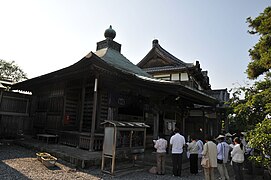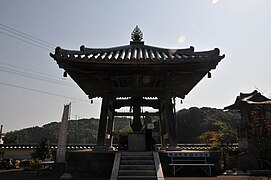Tanema-ji
The Tanema-ji ( Japanese 種 間 寺 ), with the Go Motoozan (本 尾 山) and Suzakuin (朱雀 院) in Haruno ( Kōchi Prefecture ), is a temple of the Buzan branch (豊 山 派) of Shingon Buddhism . In the traditional count, it is the 34th temple on the Shikoku pilgrimage route .
history
When Korean monks supported the spread of Buddhism in Japan from the 6th century onwards, some of them got caught in a storm on their way back after the construction of the Shitennō-ji in Osaka , which left them stranded in Tosa on Mount Akiyama ( 秋山 ). They made a 145 cm high statue of the seated healing Buddha Yakushi ( 薬 師 如 来 坐像 , Yakushi Nyorai zazō), who was supposed to ensure safety at sea, and set it up on the summit of ( 本 尾 山 ) Motoosan. That was the origin of today's Tanema-ji.
When the priest Kukai, who returned from China during the Tang period , visited this area during the Kōnin era (810-824), he built a temple complex for the Yakushi Buddha. On the occasion he sown rice, grain, beans, etc. at the temple, the seeds of which he had brought with him from China, whereupon the temple was given the name "Tanemaji", or "Temple of the Seed Field".
In the Edo period, the princes of Tosa, the Yamanouchi , promoted the temple, gave it large estates and maintained it. With the beginning of the Meiji period , the temple came under the strict separation of Buddhism and Shintoism and lost its importance.
investment
In front of the actual temple complex is the bell tower (鐘楼, Shōrō; 3), past which a path leads to the Kasuga Shrine (春日 神社; S) behind the temple. The accommodation for pilgrims (G) is also there. On the temple grounds follow the monks' quarters on the right and behind it the hall dedicated to the temple founder, the Daishidō (大師 堂; 2). Then you stand in front of the main hall (本 堂, Hondo; 1).
Worth mentioning is an open pavilion with a Kannon (子 安 観 音, Koyasu Kannon; 4) that helps to ensure safe, easy birth and a basin for washing hands from 1677. - The votive pine (燈 明 の 松, Tōmyō no matsu) in the temple garden is a reminder because the pine with its resin not only provides lighting, but also has a meaning in a figurative sense in Shintoism and Buddhism.
A memorial stone commemorates the painter who campaigned for the rural population and the lower class, Okazaki Seirō (岡 崎 精 郎; 1898–1938).
Treasures
The main cult figure , the seated Yakushi, is composed of pieces of Hinoki wood. It is dated to the end of the Heian period , is executed in the "classical style" (定 朝 様. Jōchōyō) and registered as an important cultural asset of Japan . Another, standing yakushi is of small stature with a height of 32 cm. It is made from one piece of wood and also dates from the late Heian period. The temple also has sutras from the Kamakura and Namboku periods .
photos
literature
- Kōchi-ken kotogakko kyoiku kenkyukai rekishi bukai (Ed.): Tanema-ji . In: Kōchi-ken no rekishi sampo. Yamakawa Shuppan, 2006, ISBN 978-4-634-24639-3 , p. 66.
- Oguri, Doei: Kukai. Shikoku hachijuhachi kosho no arukikata. Chukei no Bunko, 2011, ISBN 978-4-8061-4067-2 .
Web links
Coordinates: 33 ° 29 ′ 30.2 " N , 133 ° 29 ′ 15.3" E
← Previous Temple: Sekkei-ji | Tanema-ji | Next temple: Kiyotaki-ji →






